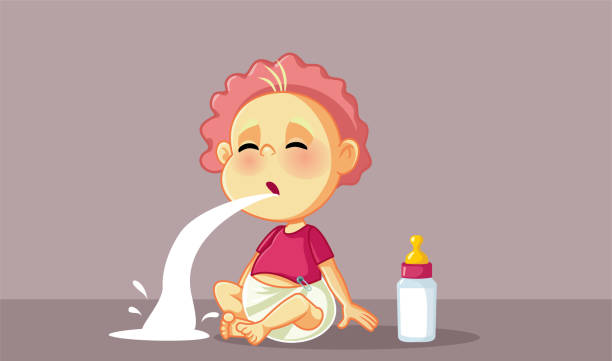Milk Allergy and Lactose Intolerance in Babies: What You Need to Know

If your baby seems to react to breast milk, formula, or cow’s milk, they might have a cow’s milk allergy or lactose intolerance. Symptoms of a milk allergy include hives, itching, wheezing, difficulty breathing, constipation, and bloody diarrhea. Signs of lactose intolerance include gas, bloating, and diarrhea. In both cases, you’ll need to adjust your child’s diet by reducing or eliminating dairy. Consult your child’s doctor if you notice any of these symptoms.
For many children, cow’s milk is a staple in their diet. It’s the base for most baby formulas and often the first beverage they try after breast milk or formula. If your baby has been drinking cow’s milk-based formula without issues, they are likely to tolerate regular cow’s milk. Even exclusively breastfed babies usually handle cow’s milk well, as they are exposed to cow’s milk protein through breast milk unless the mother avoids dairy entirely.
Cow’s milk allergy is common in babies, while lactose intolerance often develops later in childhood. It can be concerning if your baby struggles with milk, so it’s essential to understand these conditions and how to manage them.
Milk Allergy vs. Lactose Intolerance
Milk Allergy is an immune response where the body overreacts to proteins in cow’s milk, releasing histamines to fight off the perceived threat. This can cause swelling, skin reactions like hives or itching, respiratory issues such as wheezing or difficulty breathing, or digestive symptoms. Severe reactions can be life-threatening and may require immediate medical attention.
Lactose Intolerance is a digestive issue where the body cannot properly digest lactose, the sugar found in milk and dairy products. This results in discomfort but is not dangerous. Symptoms include gas, bloating, and diarrhea.
Also read: Why Your Baby’s Poop Is Green?
Milk Allergy in Babies
Milk allergies affect 2 to 3 percent of children under three. Risk factors include other allergies, atopic dermatitis, and a family history of milk allergy. If your baby is diagnosed with a milk allergy, the doctor will likely recommend a specialized formula or non-dairy milk for children over a year old. Breastfeeding mothers will need to eliminate dairy from their diets.
As your child grows, avoid foods containing milk, such as yogurt, cheese, and ice cream. Reactions to milk can range from mild to severe and may occur within minutes or hours of consumption. Always keep two epinephrine auto-injectors on hand in case of severe reactions.
Signs of a Milk Allergy in Babies
- Wheezing, coughing, throat tightness, hoarseness, or difficulty breathing
- Itching and swelling of the face, lips, or mouth
- Facial flushing
- Hives
- Eczema or rash
- Abdominal cramps or colic
- Constipation
- Diarrhea or vomiting, possibly with blood
- Chronic runny or stuffy nose
- Itchy, red eyes
Milk Allergy and Baby Poop
A milk allergy can cause diarrhea, with poop that is loose, slimy, or bloody. This can be hard to distinguish from normal baby poop, especially in the first few months. If you notice mucus or blood in the poop or other signs of an allergy, consult your child’s doctor.
Lactose Intolerance in Babies
Lactose intolerance occurs when the body cannot produce enough lactase to digest lactose, leading to gastrointestinal discomfort. It’s uncommon in babies but can occur due to genetic disorders, premature birth, severe diarrhea from illness, or conditions like celiac disease.
Signs of Lactose Intolerance
- Diarrhea
- Blood in poop
- Frothy poop
- Nausea
- Abdominal pain or cramping
- Gas and bloating
- Irritability after consuming dairy
Lactose Intolerant Baby Poop
Lactose intolerance can cause diarrhea and loose stools, along with gas and bloating. These symptoms can be similar to those of a milk allergy, so it’s important to work with your child’s doctor for an accurate diagnosis.
What to Do If Your Child Shows Signs of Lactose Intolerance
Consult your child’s doctor, who may suggest eliminating lactose from their diet for a period, conducting lactose intolerance tests, or referring you to a specialist for further evaluation.
Galactosemia
Galactosemia is a rare genetic disorder where babies cannot process galactose, part of lactose, requiring a soy-based formula. Symptoms include vomiting, poor feeding, jaundice, and an enlarged liver. Newborns are routinely screened for galactosemia.
Managing Milk Allergy or Lactose Intolerance
Treatment involves dietary changes, possibly using lactose-free formula, and ensuring your child receives adequate nutrients from non-dairy sources. Lactase enzyme supplements and referrals to dietitians may also help.
Reading Labels
Be vigilant about food labels, avoiding products with milk ingredients. Watch for unexpected sources of dairy and monitor your baby’s reactions to different foods to manage their condition effectively.
Ensuring your child meets their nutritional needs without dairy is crucial, with alternatives such as leafy greens, fortified juices, tofu, and lactose-free products. Consult with your child’s doctor about supplements if necessary.
By understanding milk allergy and lactose intolerance, you can effectively manage your child’s diet and ensure their health and well-being.
Also read: Is It Normal For My Newborn To Poop After Every Feeding?






